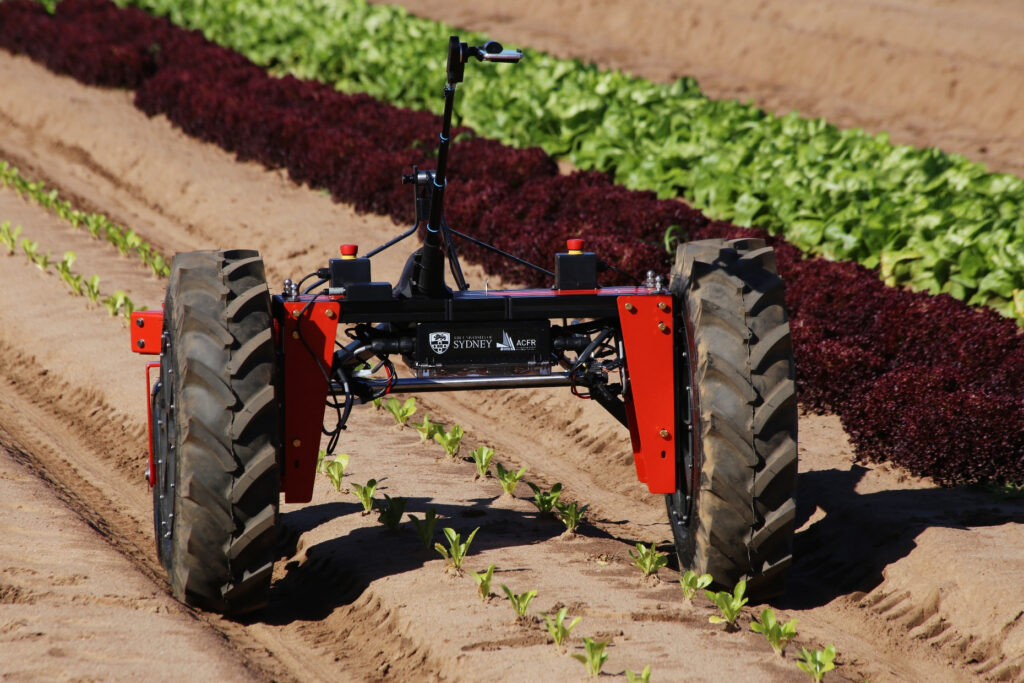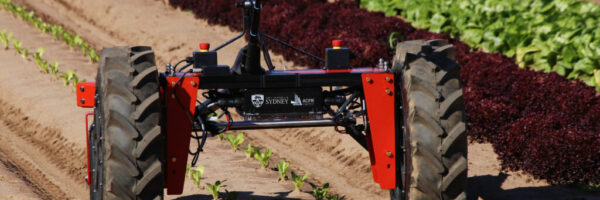
Food security appears to be the least of Australia’s problems, given we rank tenth in the world in terms of food availability, according to The Economist’s Global Food Security Index of 113 countries.
But it’s not outside the realm of possibility this could change rapidly, given the country’s propensity for floods and bushfires, which could easily ravage our crops and farmlands.
Sydney University agricultural robotics expert Salah Sukkarieh is one researcher working on supporting Australia’s and the world’s food security. He has developed a robot tractor called the Digital Farmhand that helps farmers improve crop yields by up to 77 per cent.
It’s able to tow seeders and weeders and machinery to prepare soil. It can also use digital technology to analyse crops, estimate yields and identify pests and diseases. The tractor runs on solar-powered batteries and is used for horticulture and speciality crops that are fundamental to food and nutrition security.
“The Digital Farmhand will support small-holder farmers with a tool that de-risks production and increases incomes through productivity gains,” Sukkarieh explains.
“Small, on-farm robotic platforms can deliver continuous, precision agriculture practices, at a reduced environmental footprint, and provide timely information about the state of crops. This supports sustainable agriculture practices and food security goals,” he adds.
Food technology plays an important role alongside new machinery in securing Australia’s future food supply. “We must embrace technological solutions to redress our vulnerability across the entire value chain from paddock to gut. Plant-based foods are a large part of this. It’s vital we do all we can to improve their productivity,” says La Trobe professor of plant biology Tony Bacic.
This process starts with mapping food plant genomes like the new ‘oat transcriptome’ La Trobe researchers Mat Lewsey and Monika Doblin have made available to oat breeders and biotechnologists around the world.
“Australia’s oat industry is worth $400 million a year and feeds thousands of people here and overseas every day. The more knowledge breeders have of the genetic make-up of the oat plant, the easier it is for them to create a higher-yielding, more reliable crop that is resilient and nutrient and fibre-rich,” says Bacic.
It wasn’t long ago food security was not even on Australia’s radar. Natural disasters of recent years and COVID supply chain disruptions changed all that. Few would have ever imagined supermarket shelves would be empty of bare necessities or a simple iceberg lettuce could cost up to $10.
Catherine Velisha is the director of Velisha Farms and VEG Education. She says attitudes towards fresh produce and taking abundance for granted is the biggest risk to Australia’s food security.
“This is reflected in our excessive food waste. Most Australians have never experienced severe food shortages or depressions to prompt them to be more conscious of food waste. If we can educate and change superficial views on food and how it impacts affordability, sustainability and food security, it will make a huge difference,” she adds.
ABARE statistics show we export more than 70 per cent of the food we produce. Velisha puts this down to lack of demand, given only one in seven Australians consume enough fruit and vegetables.
“Lack of local demand forces growers to export the majority of our production overseas. If demand was there, producers could secure better production plans and food security strategies and be less reliant on international consumers.
“Australians juggle cost, shelf life, appearance and sustainable packaging when we choose our food. But we can’t have it all. We have to understand the real cost of our food to help improve food security.”
Labour shortages also threaten food security, and not just when it comes to harvesting. “Lack of workers in food production is a big risk. Horticulture in particular has a very weak funnel of talent and interest coming into its workforce. We need to educate local talent around working in the food production space and how they fit within it,” Velisha says.
She believes better education about food production is needed to address these shortfalls. “Australians need to be more interested in fresh produce. Even the smallest improvement could sure up stronger food production systems, which locks in food security. It also benefits our health.”
Velisha says food producers also have a role to play. “The people in primary production need to lead this conversation. It’s time to be transparent and honest about the implications different decisions have on growers’ ability to produce fresh produce.”
Our – or at least the supermarkets’– obsession with perfect produce is another threat to food supply.
“So many fresh vegetables don’t get the chance to be sold, based on purely superficial reasons. A cauliflower with a yellow curd won’t make the shelf because we don’t want to buy it. But all the yellow means is the cauli has been in the sun. Our role is to tell these stories and explain the real costs of the current system and arm customers with the power to make better decisions. The supply chain is impacted every time something doesn’t hit a shelf or is sold cheaper because of a physical blemish.”
University of New England senior lecturer in law Siva Barathi Marimuthu notes the idea of a sustainable and secured food system is founded on a national food plan developed by the federal government some time ago that includes strategies that attempt to manage critical food security concerns.
“Unfortunately, the food plan prioritised economic growth ahead of consumer health, environmental conservation and social justice. Despite the fact the food system is related to almost every UN Sustainable Development Goal, food insecurity issues have been largely ignored.”
Food insecurity is when people don’t have access to a reliable supply of food. It involves poverty, fluctuating food prices, food scarcity, inaccessible public transportation, social isolation, environmental degradation and climate change. These factors contribute to food insecurity in varying degrees depending on where people live and the type of community the are a part of, such as urban, rural or remote.
Marimuthu says the risk of food insecurity is rising because there is no cohesive federal policy platform underpinning the goal of food security in Australia and most food security planning exercises are fragmented and either local or state-based.
“Multiple policies exist to try to solve difficulties in the food system, but they do so in very broad and general terms and, in some instance, add extra complexity to the situation. Policies in areas like food safety, nutrition in education, dietary requirements, farming practices, biosecurity, animal welfare, marine life, fisheries, water management, waste disposal and transportation are important. But, they are not sufficient to address current and future food systems.
“Priority needs to be given to food security because our lives depend on it. It must be rigorously regulated and a centralised government agency could help deliver this through a specific policy agenda. Failing this, the many gaps currently existing will continue to hinder efforts to establish a secure food system that delivers social, environmental, and economic viability.”
